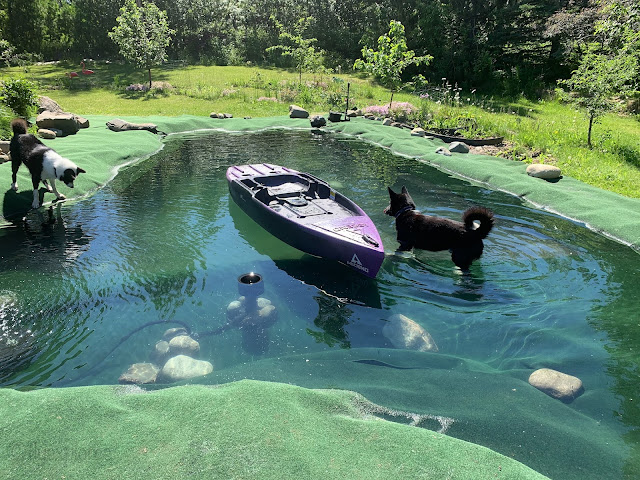Alright, now that the planning is complete, let's review supplies. There are a lot of links in this post so you can click and see exactly what I bought. I don't get any kickback if you buy these things, I've just been happy with what I bought, so that's why I'm sharing.
I ordered pond liner from Everything Ponds and was very happy with their customer service and shipping. Since dog nails would/could possibly be in contact with the liner, I opted to buy the Premium RPE 40mil liner, which is the most expensive, but also the toughest option. It should be very durable and I plan to only have to buy pond liner once in my life (for this project); I have no interest in patching liner and fixing leaks, so I bought quality.
For a long time, I was sucked (pun intended) into the myriad of options for water filters and I nearly went crazy with allllllllllllllllll the various ways, methods, strategies, and diy thingys that can be implemented to maintain a clean and healthy pond. Pond people can get intense about water filtration. Finally, I decided I'd keep things simple and bought a few pumps/filters that I just need to plug in and clean occasionally. I'll post any filter updates here.
 |
| 7 feet of crystal clear water. |
A skimmer is a must have for pulling in all of the crazy amounts of dog fur that floats on the surface of the water every time a dog swims. I got one that just sits in the water, rather than a box kind that I'd have to build into the side of the pond - that seemed like a lot of work, and this one is easy peasy. It needs a pump to suck the water, so I bought this super quiet pump that was recommended by someone else: I think it is a little too high tech for me, but it's working ok and is strong enough to do what I want it to do.
 |
| Look at all that dog fur! |
I connected the other end of the skimmer/pump to a little waterfall box and it is so cute. I bought some filter materials and turned the box into an actual water filter, so I can benefit even more from the pump moving the water. I created something similar to what Ha Y N Fish Keeper shows on youtube (he's fun to watch, by the way).
Two "all in one" filter set-ups provide water cleaning and aesthetics to my pond: I bought two of these filter systems, because I liked the lights and the ease of use. So far, they are super easy to use and clean.
 |
| I need more lights! |
One final filter is a simple box filter that I run with another quiet pump of the same brand as mentioned previously, just a lower powered version. I connected it to a little frog spitter to return the filtered water back into the pond.
So, I have a total of four filters for my pond: three filter below surface water and one filters surface water. If you do the math for how much water these filters clean, it comes to about 4,350 gallons per hour. This is extremely inadequate, according to the pond websites, for my 20,000 gallon pond. However, I believe my pond will remain sufficiently cleanish regardless, based on my small number of fish and keeping the surface clean of debris, but I guess we'll find out! I'll link an update post here and let you know how it's going.

In addition to mechanical filtration, I bought two live lily plants and several cloth pots to sink into the pond to act as biological filtration. I also sourced some local pond plants and bought two bags of pea gravel to plant the roots in the cloth pots - the pea gravel seems to be cleaner (after I rinsed it) than using "pond soil" that is commonly sold. So far, my plants are thriving being planted in pea gravel, and I assume are taking up nutrients from the water. I can do a post on the plants, if there's interest, but essentially they exist to pretty up the pond, provide shade on the surface to prevent algae growth, remove nutrients from the water to prevent algae growth, and provide additional oxygen to the water. I'm trying to keep my pond water as clean and healthy as possible, since I don't have a beefy mechanical filtration system.

Around the edge of the pond, for the skirt or apron, I bought what was advertised as cut to length astroturf/artificial grass, but it seems more carpet-like than turf-like. I am very, very happy with this purchase: it covers the edge of the pond liner and makes my pond look "finished" I think.
Rocks are not something I had to buy, because Alaska is essentially a giant gravel pit and I had plenty of rocks on hand, but they are another thing I used for the pond, so I'll mention them here; one more tool I should mention is some sort of digging thing, you know, to make the hole for the pond. We used our backhoe and shovels.
Alright, those are the supplies. All-together, I believe the project cost about $5,000. It could have been made cheaper if I had been less extravagant with the liner and if I had not added the skirting astroturf.
Shall we dig in and make this pond happen? Construction is next in the series.




















































